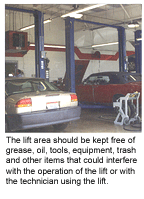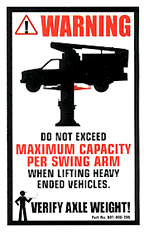Lifts play an important role in the day-to-day operations of any automotive service facility. Some may even argue that a lift is a shop’s most valuable employee. After all, lifts never call in sick or go on vacation. However, one of the worst things a shop owner can do is fall into the trap of taking lifts for granted.
Lifts are critical to shop productivity and should be inspected on a daily basis. Prior to the start of each workday, lift arms, operating controls, safety devices and all other lift components should receive a thorough inspection to ensure everything is operating correctly. The shop area around the lift should also receive a quick inspection to make sure it is clean. The lift area should be kept free of grease, oil, tools, equipment, trash and other items that could interfere with the operation of the lift or with the technician using the lift.
A lift can be a very dangerous piece of equipment if not used properly or used by technicians who have not received the proper training. Shop safety should be a top priority of every shop owner and technician. Every technician who will be using the lift or working in close proximity to the lift should be trained  on proper lift operation as well as given pointers covering proper lift maintenance.
on proper lift operation as well as given pointers covering proper lift maintenance.
Training should include:
• Proper spotting of the vehicle;
• Use of the operating controls;
• Understanding lift capacity;
• Proper use of jack stands; and
• Proper use of safety devices.
Operator error, lack of training and lack of maintenance are the primary causes of accidents involving lifts. Making sure everyone in the shop has received the proper training can reduce the chances of having an accident involving one of the lifts in the shop.
Never raise a lift with someone in the vehicle or on the lift and never lower a lift without first checking to make sure the area is free of people and equipment.
It’s also important to never overload a lift. The manufacturer’s rated lift capacity is shown on a nameplate affixed to the lift. Making sure lift operators understand “lift capacity” is very important. This isn’t as straightforward as it may seem. Never assume that just because a lift has a 9,000-lb. lift capacity, that it can safely lift an 8,000-lb. vehicle.
For example, a four-arm lift with a lift capacity of 9,000 lbs. has a single-arm lift capacity of 2,250 lbs. An 8,000-lb. vehicle could overload this lift if the vehicle weighs 3,000 lbs. in the front and 5,000 lbs. in the rear. The two rear arms on this lift would be overloaded by 250 lbs. on each arm. To help prevent lift overload, lift pressure gauges are available on some models that allow the lift operator to compute the weight of the vehicle being lifted within an accuracy of up to 2%.
Lift Certification
When shopping for a lift, you will see ones that come with a certification label. According to the Automotive Lift Institute (ALI), certification is a system whereby an independent, third party organization determines that a manufacturer has the ability to produce a product that complies with a specific set of standards. Certification further authorizes the manufacturer to use a controlled label on listed products that are certified. Lastly, certified products are periodically checked to ensure they continue to meet the standards. ALI sponsors such a program for automotive lifts.
 ALI contracts with Intertek Testing Services (ETL), a worldwide testing organization, recognized in the United States by the Department of Labor, Occupational Safety and Health Administration (OSHA) as a Nationally Recognized Testing Laboratory (NRTL), to fully manage the program in accordance with the Program Procedural Guide. ALI has taken the additional step of obtaining accreditation for this program from the American National Standards Institute (ANSI). This assures absolute independence and unquestionable integrity for the program.
ALI contracts with Intertek Testing Services (ETL), a worldwide testing organization, recognized in the United States by the Department of Labor, Occupational Safety and Health Administration (OSHA) as a Nationally Recognized Testing Laboratory (NRTL), to fully manage the program in accordance with the Program Procedural Guide. ALI has taken the additional step of obtaining accreditation for this program from the American National Standards Institute (ANSI). This assures absolute independence and unquestionable integrity for the program.
There are several states that require automotive lifts to be certified. Before purchasing a lift, you should check building codes in your state see if there are any guidelines you need to follow. You don’t want to purchase a lift and then find out a year or two later that the lift you purchased is in violation of state codes. Once a lift has been installed, there is no way to obtain certification for a lift. It’s also important to note that, according to ALI, use of non-certified options or accessories on a certified lift will void the certification of the lift.
Meeting a Shop’s Needs
Whether you are adding a lift or replacing an older one, take time to inspect all the different lift options that are available in today’s marketplace. Unperformed maintenance is a hot topic in the automotive aftermarket and a part of the reason some needed service goes unperformed is because a shop may not have the right equipment to perform an inspection and repair. Anytime a vehicle is on a lift, technicians should be taking the time to look at the suspension, steering, brake and exhaust systems.
The types of repairs offered at your shop should have a large influence on the type of lift you purchase. You don’t want to have your technicians uncover needed service and then not be able to perform the repairs because the shop is equipped with the wrong type of lifts. For example, steering systems should be checked with the full weight of the vehicle on the wheels. In order to accomplish this, a drive-on, ramp-style lift is often required.
However, there are also adapters available that can turn a two-post lift into a drive-on lift. So, don’t rule out any lift before you are aware of all of its features and accessories.
If you have not shopped for a lift in a few years, you may be surprised by all the new technology that is available. Some of today’s lifts are even equipped with LCDs that display vehicle service instructions, as well as vehicle lift points. Lifts are an expensive investment so you need to make sure you choose the lift that best fits your technicians’ needs.
Take the time to sit down with everyone in the shop and discuss the shop’s lifting needs. Compile a list of lifting requirements and find out what accessories and adapters technicians would like to have for the new lift.
Before starting your search for a new lift, make sure you can answer the following four questions.
1. How much bay space is available for the new lift?
2. How heavy are the vehicles that will be lifted?
3. What type of service work will this lift be used for in the shop? and
4. Is the building leased?
Knowing the answers to these questions before you begin your search will start you in the right direction. With the help of a lift distributor or manufacturer representative, you are now ready to look at the advantages and disadvantages of each lift you are considering purchasing. A part of the pre-lift purchase preparation is carefully planning where the lift will go in the shop to maximize shop space.
If you are planning on using the lift to service delivery vans or trucks, the lift must be able to raise the vehicle high enough for the technicians to be able to work comfortably under the vehicle. You also must make sure there are no overhead obstructions that would get in the way when a vehicle is fully lifted.
Site Visit
While talking to a lift salesperson, ask them to visit the shop so they can get a better idea of your needs. While at your facility, the salesperson should be able to make suggestions concerning lift placement as well as provide you with the advantages and disadvantages of each type of lift. They should also look at the proposed installation area and alert you to any installation roadblocks you may encounter, such as overhead obstructions, wiring and air needs, the ability of your shop floor to handle the weight and building codes.
If you are considering purchasing an above-ground lift, you may need to drill a test hole in the floor to verify the shop floor’s thickness. The lift manufacturer can supply you with floor specifications that are required for each model of lift. Bypassing this step can result in extra cost and delays when it is time to install the new lift. It is also not a bad idea to drill holes in multiple locations to make sure there is a uniform thickness in the floor.
If your facility is leased instead of owned, you also need to consider the future of your business when purchasing a lift. Most lifts are designed to last about 20 years and some lifts are easier to move than others. If you have plans to relocate or renovate your facility in the future, take this into consideration when deciding what type of lift to purchase.
When choosing a lift, be sure to ask the salesperson about parts and service. If your shop is like most, you can’t afford to have a lift sitting idle for a month while you wait for parts to be ordered and then for the manufacturer to send out a repairman.
You also want to consider accessories and the ability to upgrade the lift you are looking to purchase. Every type of lift, be it above- or in-ground, has a wide variety of accessories available that can be of great help to the technician depending on the repair job being performed. Much like when buying a car, be sure to ask what options are available on the lift you are looking to purchase. You want to make sure you get the accessory package that best meets your shop’s service needs. It’s best to purchase all the accessories and adapters that you think your shop may need when purchasing the lift. You don’t want to find out a month after buying the lift that you are losing business to the shop down the road because you don’t have the necessary equipment to complete the job.
If you are considering purchasing a new lift or are concerned about how safe the lifts are that you are currently using, ALI is an excellent source for safety material and information of vehicle lifting points. Visit www.autolift.org or call 321-722-9993 for more information.












